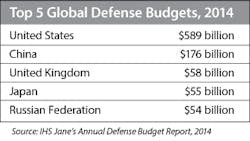Supply chain companies serving defense markets have watched as shrinking budgets in the United States have slowed business to that sector, and many have started to broaden their reach to new market opportunities as a result. Such decisions are proving to be wise, as a new report from industry researcher IHS predicts a flattening global defense market over the next two years accompanied by key changes in the market going forward.
In its Defense Budgets Annual Report, the researcher notes that declining oil prices will hinder defense market growth in the Middle East and Africa over the next two years, and that Asia Pacific is set to become the driver of world growth by 2020. The report also says that by 2019, NATO will no longer account for the majority of global defense spending for the first time in the alliance’s history.
“Spending in Asia Pacific, meanwhile, is expected to grow to [$547 billion] by 2020, over 30% of the global total,” according to Craig Caffrey, senior defense budgets analyst at IHS Aerospace & Defense.
Other key findings include:
- The United Kingdom resumed its position as the third-highest defense spender in 2014, ahead of Japan, Russia, and France.
- Russian defense spending is forecast to reach its peak of $63 billion in 2015.
- India is forecast to become the third largest defense market by 2020.
Asia Pacific Drives Growth, U.S. Declines
Growth in Asian defense spending is expected to increase from 3.3% in 2014 to 4.8% in 2015, making the region a global leader of growth going forward. What’s more, by 2020 defense spending in the region is set to outpace that of the United States if sequestration continues here at home. Today, the United States outspends Asia Pacific by $170 billion.
“By 2020, the center of gravity of the global defense spending landscape is expected to have continued its gradual shift away from the developed economies of Western Europe and North America and towards emerging markets, particularly Asia,” Caffrey said. “In terms of overall growth in each region between 2015 and 2020, Asia Pacific is expected to solidify its role as the key driver of growth in the defense sector.”
The change in global outlook is compounded by slowing conditions in the Middle East and Africa, where falling oil prices are affecting the short-term outlook, IHS says. The region saw a 30% increase in defense spending from 2011 to 2014, but such conditions are ending as the region struggles with the economic challenges of lower oil prices.
Here at home, companies supplying the U.S. military market continue to face tough times, as shrinking budgets are expected through fiscal year 2019. This is due to both declining troop strength in Afghanistan and ongoing pressure from sequester reductions, analysts said. They expect investment, procurement, and research and development in FY ’14 in the United States to be at its lowest value in a decade, with even lower investment projected for FY’15.
“We expect a decent increase in investment starting in FY’16, yet dependent on a potential sequester becoming reality once again,” said Guy Eastman, also a senior defense budgets analyst at IHS Aerospace & Defense.









